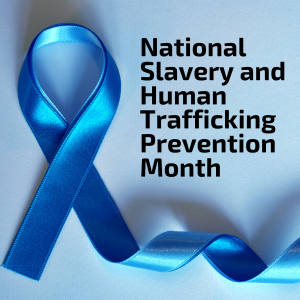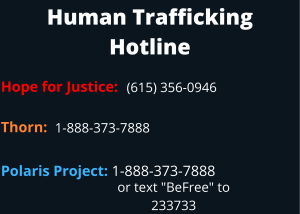
Canva by Layal Srour
Modern slavery, or human trafficking, is described with three elements: The Act, The Means and The Purpose. This month, for National Slavery Human Trafficking and Prevention month, people around the world are using their resources and efforts to put a stop to these heinous acts.
About Modern Slavery
“I think the issue about human trafficking is still very understated,” Ixchele Ortiz, junior special and early education major, said. “A lot of it hides from multifaceted-massive systems that constantly exploit individuals.”
Human trafficking and slavery is “the exploitation of another person for labor, domestic servitude, or commercial sexual activity by force, fraud, or coercion. It is also the act of enslaving or exploiting unwilling other people.”
When people are trafficked, they are victims of four types of exploitation – sexual exploitation, domestic servitude, forced labor and organ harvesting.
Sexual exploitation is when a person is trafficked for sex and are controlled by “violence, threats, substance abuse, deception or grooming, with extreme physical or psychological domination.”
Domestic servitude requires the victim to provide services while living in or on the property of the traffickers.
Forced labor is when the victim does work under the threat or penalty of harm to their family. These victims are usually tied to their traffickers by debt bondage and are most likely to never get out.
Organ harvesting is when the person is “specifically chosen for the harvesting of organs or tissues, such as kidneys, liver etc. without consent, to be sold.”
Human trafficking can be internal and external, where internal is within the same city, state or country and external is internationally. Often times people get tricked into being trafficked without knowing, especially internationally. When someone gets offered a job overseas, they take that opportunity to go, knowing that the money will help their family back home. However, they end up leaving their families to an unknown area where they do not speak the language, have no money and are forced to work for these traffickers where he may never leave and return home.
As for internal trafficking, most victims are picked up, or kidnapped, from their hometown and taken to a different city or state within their country and are sold for sex.
Currently, there are “40.3 million people in forced labor, domestic servitude, sexual exploitation and forced marriage world wide and $150 billion made each year from forced labor.”
Hope for Justice, an organization to help put an end to trafficking, have rescued hundreds of people “including babies younger than one years old and adults up to the age of 63.”
Spot the Signs
Hope for Justice put together key indicators to know if someone is a victim of human trafficking and modern slavery.
- Secretive
- Agitated
- Online more
- Withdrawn
- Refuses to Talk
- Deception
- Restriction of Movement
- Abuse of Vulnerability
- Withholding of Pay
- Abusive working/living conditions
- Retention of ID documents
- Physical or sexual violence
- Debt Bondage
- Fear and Anxiety
- Intimidation and threats
Get Involved
There are many organizations that can help people get involved with the fight against human trafficking. Three organizations to get involved in the prevention of human trafficking and slavery are Hope for Justice, Polaris Project and Thorn.
“I honestly believe that starting simple conversations about how sensitive this topic could be, and being able to still have those conversations could raise a level of awareness that people who doesn’t care enough about the topic, or never heard of the extremity of this issue, could definitely impact them towards doing more,” Ortiz said.
With Hope for Justice, people can get involved with email updates, by becoming a guardian and giving monthly donations to the organization, get involved with their fundraising, volunteer with the organization, pledge your birthday and spread awareness on social media platforms.

Canva by Layal Srour
In visiting Thorn.org, their work is guided with the use of three principles, such as accelerate victim identification, equip platforms, and empower the public to spread the word for the fight against human trafficking and to eliminate child sexual abuse from the internet. As of 2018, it has been reported that with the help of the FBI, CIA, and Thorn, Ashton Kutcher helped save 6,000 child victims from sex trafficking. Kutcher said, “You can roll up your sleeves to be like a hero and go save one person, or you can build a tool that allows one person to save a lot of people.”
To join the fight against human trafficking, get involved by signing up to stay up to date on all the issues through Thorn, donate, show support with merchandise, listen to survivors, speak up, and advocate.
Cabrini alumna Michelle Guerin said, “This really speaks to who Ashton is. To step away from the spotlight and help [support] a social justice issue, such as human trafficking, is incredible.”
With the Polaris Project, people can take action and get involved by giving a one-time or monthly donation, bring awareness and fundraise on social media using their different fundraising platforms on their website and on Instagram, Facebook and Tiltify, which allows you to collect donations on Twitch and YouTube. Lastly, sign the pledge to join the movement and learn about “what makes people vulnerable to trafficking, how you are uniquely situated and listen to survivors of human trafficking.”
Finally, for anyone who is interested in learning more about this issue please visit these sites, apply for a career or volunteer opportunity and join Catholic Relief Services on campus.


